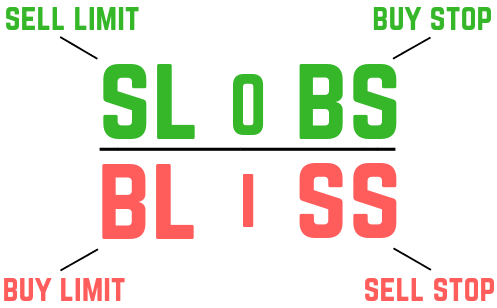In conclusion, it’s important to remember where the market needs to go for an order to trigger or execute. Many use “SLOBS” and “BLISS” to help them recall how order types work. The following visual is great to memorize and re-write on your scratch paper while taking the Series 7 exam:

As you can see, using this visual can help you remember how these orders work. With sell limits above the line, this tells you they execute when the market price is at or above the limit price. With buy limits below the line, they execute when the market price is at or below the limit price.
Stop orders don’t execute immediately, but they trigger at specific market prices. Utilizing the SLOBS/BLISS visual, sell stops trigger when the market price is at or below the stop price. Buy stops trigger when the market price is at or above the stop price.
In case you were wondering, the ‘O’ in “SLOBS” and the ‘I’ in “BLISS” are only there to make an acronym.
Another item worth noting is when certain orders are adjusted for cash dividends.
When a company pays a cash dividend to their shareholders, their stock price drops by the amount of the cash dividend on the ex-dividend date (the day the stock begins trading without the dividend). The company loses an asset (cash), therefore the company is worth less than they were before the dividend payment.
Assume you place the following order:
Buy 100 shares of GE stock @ 15 limit
GE stock is trading at $15.50.
You want to purchase 100 shares of GE stock, but not unless they’re trading for $15 or less. With the stock trading at $0.50 above, the order remains open (unexecuted).
If GE pays a dividend of $1 per share, its stock price will fall to $14.50 (from $15.50). Your order would go through due to the dividend payment, not because of market forces.
By default, broker-dealers adjust orders placed below the market (buy limits and sell stops - see SLOBS/BLISS above) to avoid this circumstance. Most investors that place orders “away” from the current market want their order to fill due to market forces, not just a dividend.
Placing an order “away” from the market means placing an order that cannot currently be filled. For example, placing a sell 100 shares @ $30 stop when the market is at $31. The order cannot execute until the market price is $30 or below, therefore the order is “away” from the market
Occurring on the ex-dividend date, buy limits and sell stops (orders below the market) are adjusted downward by the amount of the dividend. For example:
Buy 100 shares of GE stock @ $15 limit
becomes
Buy 100 shares of GE stock @ $14 limit
If GE stock fell to $14.50 after a $1 dividend, your order would not go through due to the adjustment. The market price must now fall to $14 or below for your order to execute.
This adjustment occurs for all buy limits and sell stops unless the acronym “DNR” (Do Not Reduce) is a part of the order. For example:
Buy 100 shares of GE stock @ $15 limit DNR
Even if GE stock pays a $1 dividend, this order would not be reduced. Assuming a market price of $15.50, a $1 per share dividend would force this order to be filled immediately on the ex-dividend date.
Sign up for free to take 4 quiz questions on this topic